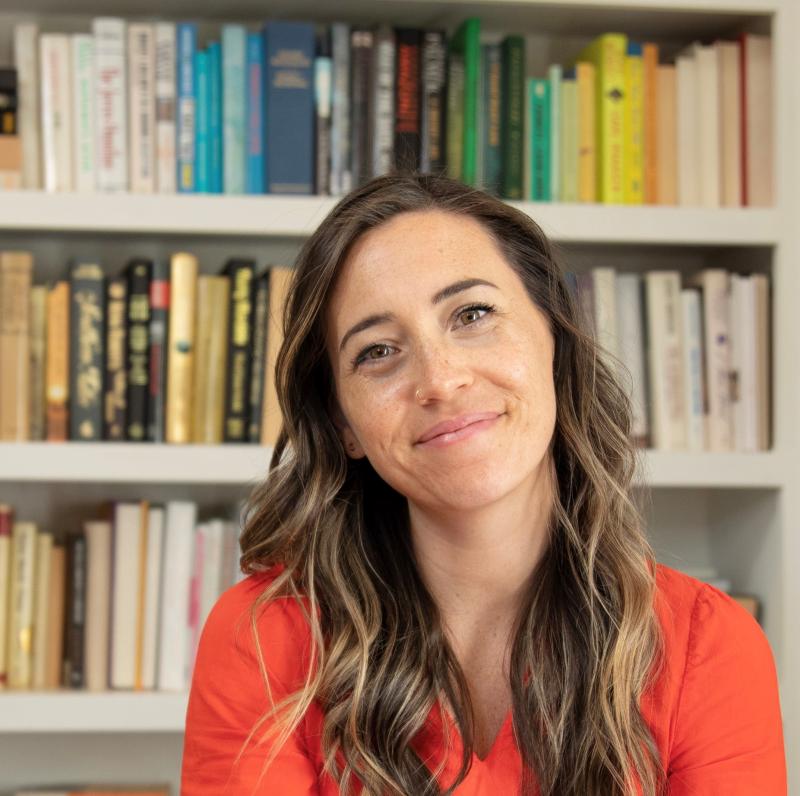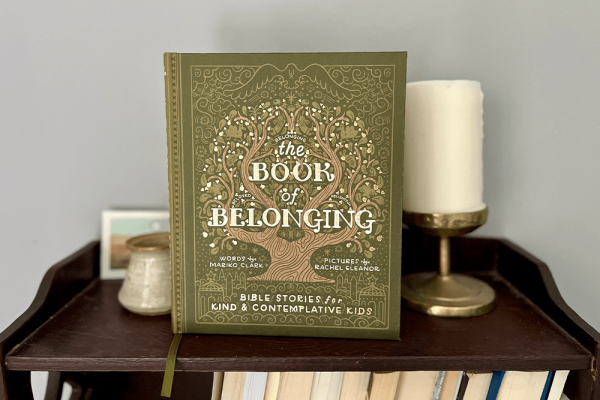Early in The Book of Belonging, a long-anticipated children’s story Bible, author Mariko Clark includes this paragraph:
“Think about how cozy and special you feel when someone asks you about your day or wants to learn more about your favorite foods or hobbies. God made us to belong with God! That means God wants to be close and cozy with us. So all questions are welcome!”
The invitation comes right after the creation story and the author’s acknowledgement that people believe different things about the story — some believe it is a literal retelling of a seven-day creation; some believe it is a poem recounting a story humanity will never fully comprehend. After inviting young readers to ask their own questions, Clark goes on to affirm that uncertainty and wonder go hand in hand.
“Hopefully, you will spend your whole life asking important questions about God. Sometimes there will be easy answers. Sometimes you will decide on one thing and change your mind as you learn more. And sometimes you get to giggle and throw your hands up and decide, That is something only God could understand!”
Questions, not answers, play a central role in the newly published The Book of Belonging, Clark said, because it was a question that began the entire project. In 2020, Clark’s pre-school-aged daughter Aidah asked, “Does God love boys more than girls?”
Clark was surprised by her daughter’s question, given the lengths she had gone to not to pass on the male-centric, fundamentalist religion she’d grown up with. But her daughter told her that she’d gotten the impression that boys were more important to God from her story Bible, which featured only two stories with women as named characters. “It was disproportionate in a way I wasn’t expecting,” Clark said, recounting her survey of the story Bible.
She wondered if her daughter’s book was an outlier. It wasn’t. Clark ordered the top eight children’s story Bibles on Amazon and scoured them in search of women. Across all eight books, only 7 percent of the stories had a female main character, 19 percent of the stories mentioned a woman by name, and 23 percent of the pictures showed women.
“It was a sea of beards as far as the eye could see,” Clark said.
Other subtle signals about who God seemingly loved more popped off the pages as well. Blonde angels. Light-skinned Jesus. Tidy morals and easy answers. It certainly didn’t reflect the historical context of biblical events, or the often-messy, sometimes mysterious faith Clark knew well. She decided to write a story Bible that would reflect that faith. And beyond including basic Bible knowledge, her story Bible would also include contemplative practices. She wanted fewer foregone conclusions, and more wonder.
Because of her background in publishing with National Geographic Learning, she knew how the market worked. If the story Bibles she surveyed were all focused on the same message, there was a reason: It’s what people were buying. But Clark also suspected that there was a market for something different. She reached out to artist Scott Erickson for guidance on contracting with an illustrator who could help her create some sample chapters for a Kickstarter campaign. Hearing Clark describe her goals, he put her in touch with Atlanta-based illustrator Rachel Eleanor. In response to her inquiry email, Clark said she received a “spicy” response that confirmed she’d found the right illustrator.
Illustrating an inclusive children’s Bible
Eleanor was coming out of a frustrating and hurtful experience in what she thought had been a welcoming, inclusive church. As she and her husband had been nudging their congregation toward open affirmation of LGBTQ+ people and families, church leadership had been cheering them on. But as soon as the “parent” churches in the network got wind of the Bible studies and Sunday morning classes exploring queer-affirming faith, they stepped in and demanded Eleanor and her husband abandon their mission.
The months and years after were painful, Eleanor said. As her faith exploration “was getting bigger and bigger and bigger,” she had trouble finding a church willing to wonder and explore with her. After her deconstruction process, Eleanor found her way back to the Bible, not through a church, but through a Common Ground Pilgrimage with Not Sorry, a literary group that focuses on sacred readings of secular texts in small, committed groups.
As she cautiously reengaged with the Bible, Eleanor no longer wanted to use her work to promote non-affirming, restrictive doctrine and church policy, so when Clark reached out with an inquiry for a children’s story Bible, Eleanor said she had a lot of questions to make sure the project was something she could take on in good faith: “I gave Mariko the third degree.”
rachel_eleanor_author_photo.jpg

During the pandemic, Clark’s suspicions about the growing market for the book were confirmed. Without Sunday School and children’s church administering Bible stories, more parents took on their children’s religious education. They soon realized, as Clark had, that the available resources were sorely misaligned to their understanding of an inclusive God and less fundamentalist reading of scripture. When they launched the Kickstarter campaign in 2021, the project met its $73,000 goal within 10 days and was $20,000 over the goal by the end of the campaign.
Elizabeth Ross participated in the Kickstarter campaign in 2021, a year into her role as a spiritual director and a few months into parenthood. She knew that finding a children’s Bible was going to be important as she and her husband considered how to introduce scripture to their youngest. From the very beginning, she said she loved TheBook of Belonging’s “very clear acknowledgement that we don’t know everything and it’s okay to say, ‘I don’t know.’”
The early response wasn’t all enthusiasm and support, however. Critics of the project came quickly, and they were forceful, Clark said. Many accused the duo of having a sinister agenda to undermine “Christian values” — which Clark saw as code for rigid and patriarchal norms.
Their critics were voicing the very beliefs that The Book of Belonging was trying to remediate. But since they’d seen that side of Christian culture before, neither Clark nor Eleanor was intellectually shaken. In fact, Clark said, even though some criticism was unnerving, remembering those early reactions energized her when she doubted the project.
“It gave it the flavor of John Lewis’ ‘good trouble,’” she said.
mariko_clark_author_photo_credit_-_craig_thompson.jpg

The campaign caught the attention of many in the growing community of Christians looking for churches, books, and teaching based on a more progressive and inclusive understanding of the Bible and Jesus’s teaching. Among them was columnist and literary agent Jonathan Merritt, who convinced Clark and Eleanor that their project would benefit from the resources and support of a publishing house. Clark was worried this would mean conforming the project to the tried-and-true market of Christian books, which have skewed toward evangelical and conservative interpretations of the Bible.
To her surprise, she said, Merritt introduced them to a growing sector of Christian publishing that was open to breaking the mold. The partnership with Convergent, Penguin Random House’s spirituality-focused imprint, has been a happy one, Clark said, and another confirmation that they are part of a movement, not just a project.
Once deals and deadlines were set, Clark and Eleanor got to work on the long-distance process of writing and illustrating The Book of Belonging. With Clark in Indianapolis and Eleanor in Atlanta, they had to make the most of writing retreats, which the two say quickly became like spiritual retreats.
“It was the best and most fruitful creative process,” Eleanor said.
The synergy shows in the design, which balances showing and telling. In the crucifixion story, for instance, Clark left blank space for Eleanor to illustrate the mystery and confusion inherent to the hours and days of Jesus’ execution. More of Clark’s words are used to do the heavy lifting required to present the Bible as a book of questions.
Parenting and re-parenting
When Ross received her copy of The Book of Belonging in late August, she said she was immediately taken with the beauty of the book itself. Her daughter, now 3 years old, loves it as well. It’s added a particular delight for Ross in their nightly ritual of reading “a God book,” she said. Like Clark, she’d found that other story Bibles often told the stories in a way that didn’t represent the way she wanted to teach her children about God.
“It’s such a fun read for me as the parent because it’s a book I don’t have to necessarily work as hard to pre-read or censor or skim,” she said.
As she looked through the book, Ross said, she immediately went to her husband, himself a curate in the Episcopal Church, and urged him to read some of the retellings. Instead of emphasizing sin, depravity, and the other hallmarks of original sin doctrine, the approach seemed based in what theologians call “original goodness” — a theological emphasis on the inherent bond between God and creation. She was particularly impressed, she said, by the way the author and illustrator handle weighty stories like the Fall, the Last Supper, and the crucifixion.
“I loved how this book leaned into the emotional and spiritual depth without going into intense detail,” Ross said. “This style of retelling honors the scriptural stories long held by Christian tradition and makes plenty of room for the wisdom children bring through their own observations and questions.”
Ross said she’s glad that her children will have Clark and Eleanor’s words and images as part of their early formation, and she feels the book ministering to her as well as she reads it aloud.
“Going back and rereading these stories through my daughter’s eyes is kind of like re-parenting,” Ross said.
Finding faith belonging while writing
Both Clark and Eleanor saw their faith grow throughout the years of the project as they confronted not only their own doubts about the work itself, but also the challenges of their lives outside the book.
“Mari and I both had to pull each other out of spiraling phases,” Eleanor said.
During one spiral, Clark found herself inside the text in a new way as she retold the story of Moses and the burning bush. When Moses doubts his ability to lead the Hebrews out of Egypt, God doesn’t try to reassure him by convincing him that he is talented and qualified. God simply promises to accompany Moses. For Clark, rather than trying to empty the well of imposter syndrome through self-affirmations, she found comfort in God’s presence in the project. When she wrote, “I am with you,” on the page, she knew God was saying that to her as much as the burning bush was saying it to Moses.
The book had never been fully separate from Clark’s journey as a mother of three. But for Eleanor, motherhood would come as an added dimension to the work as she experienced miscarriage, pregnancy, the birth of her first child, and postpartum depression all while illustrating stories deliberately inclusive of women and their sacred roles inside and outside the home.
Eleanor found particular meaning in the story of Mary, which she illustrated as a form of contemplative prayer. As Mary held her son Jesus at his birth, said goodbye to him at the crucifixion, and reunited with him after the resurrection, Eleanor found herself deeply connected to the emotions of Mary’s motherhood. The stories were not just classic fixtures of Christian dogma, but a mother’s lived experience.
Both women found a particular comfort in their retelling of Jesus’ parable of the prodigal son, which was the actual story Eleanor was working on when she gave birth to her son, Finn. Like many parents who have moved away from fearful or rigid faith traditions, both mothers sometimes wondered whether they were getting parenting right. Amid the dearth of resources that led them to publish The Book of Belonging, they find comfort in the core message of their retelling of the prodigal son.
“God is for you. God loves you for who you are, not what you do.”
Got something to say about what you're reading? We value your feedback!

